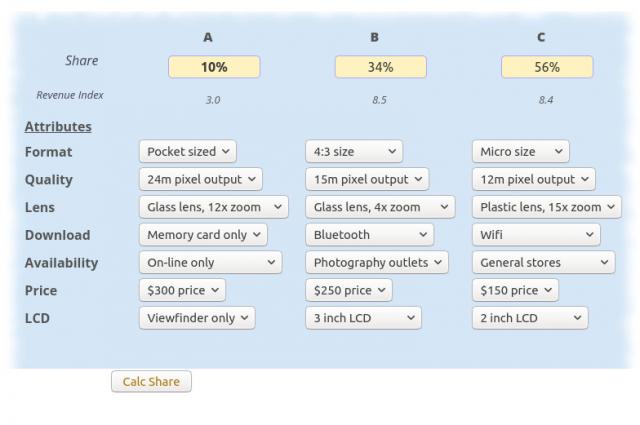Conjoint analysis - market modeling demonstration
 Modelling is a core part of a conjoint analysis market research study. This demonstration shows how understanding choices can be used to predict market share (strictly "share of preference") and possibly revenue or profit potential by changing product features. Our Cxoice Conjoint Explorer shows the full link between attribute design to model output to explore conjoint analysis methods.
Modelling is a core part of a conjoint analysis market research study. This demonstration shows how understanding choices can be used to predict market share (strictly "share of preference") and possibly revenue or profit potential by changing product features. Our Cxoice Conjoint Explorer shows the full link between attribute design to model output to explore conjoint analysis methods.
Other types of pricing and trade-off research also lead to other types of market models for example as Pricing research or Brand-Price Trade Off research. Models are a major benefit of conjoint and trade-off studies over other forms of quantitative market research.
Forecasting demand using market models...
Imagine you are a digital camera manufacturer, you want to know how changes in specification affect demand - what's the best spec and price to set?
The utilities from conjoint analysis can be converted into an interactive market model, which estimates how changes to product and service impact on demand, and revenue. This illustration is not currently operational, but shows the principles for models, allowing what if games to be played and product positioning and pricing to be optimised. The notes below explain how and when such modelling works best.
Models as the key output of conjoint analysis...
Market modelling, also known as a market simulation, is one of the key strengths of conjoint analysis. In conjoint analysis, customers are shown a variety of possible products (or services) and asked to say which they prefer. By analysing the preferences against the specification of the products shown statistically, the underlying preferences can be worked out, such that preference for products that were not tested can be evaluated (see conjoint design) to produce a conjoint analysis model to explore different sets of preferences across the market as a whole.
Using these values (utilities or part-worths) from the conjoint research a market model can be created like the one above, based on what drives customers' decisions. This allows businesses to model and test different product and service options to evaluate likely market preferences and potential share, revenue and profit, all based on what customers' really value. Consequently you can look at what projects would best improve your offering to customers and estimate their effect on share to find out which options give the best return on investment.
Share, demand curves, price elasticity and revenue optimisation...
Share in a market model is known as "Share of Preference". This is the expected share if your customers knew all the information and all the products had the same level of distribution. Combined with information about distribution and advertising this can provides estimates of market demand. If prices and costs are known the model can be extended to include revenue and profit potential.
Our interactive pricing explorer shows how understanding the demand curve feeds into sales, revenues and profitability, and so why the business needs to be able to estimate demand.
Models can have extra parameters to take external effects into account and so provide models that more closely reflect the real market. A further element missing from this simple model is the ability to look at different subgroups and segments to see if a range of products could do better than a single product in the market.
Note that the ratings must reflect what your customers perceive the position to be. Often customers' perceptions do not reflect reality and so changing the ratings on the attributes may be more about communication than changing the actual delivery. Often we find that simple service features such as delivery, availability of help, keeping promises and so on can have bigger market effects than changing price or specific product features.
For this model we have had to simplify so that it fits on the page and please note that the data are artificially for demonstration only, and do not reflect any real life situation.
For help and advice on conjoint analysis, market modelling and market simulation contact info@dobney.com